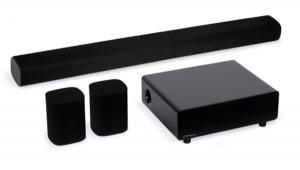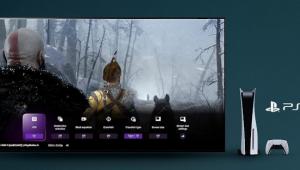Playbar: The new soundbar from Sonos

There are a zillion soundbars out there, and it seems like every one of them has something missing: a key feature, total integration with your TV or, worst of all, good sound. But from what I saw last week on a press junket to the Santa Barbara, Calif., headquarters of Sonos, it looks like maybe somebody finally got it right.
The $699 Playbar, available on March 5, is Sonos' attempt to, as the company put it, "crash the home theater party." It combines all the usual wireless music features you get in Sonos products like the Play:3 with one of the most thoroughly engineered, completely thought-out soundbars I've encountered. Every time I asked a question about the Playbar, the response not only satisfied me but wowed me.
The basic idea
Behind the grille of the 35.4" long bar, the drivers are angled 45 degrees. This design twist lets you place the Playbar on a stand or table in front of your TV, or mount it on the wall above or beneath your TV. Mounting keyholes are provided in the back, or you can get the optional $39 bracket that allows more mounting flexibility. The Playbar senses its position and the way it's mounted, and automatically adjusts its internal equalization to compensate. An IR repeater with long emitter strips in the back assures that the Playbar doesn't block operation of your remote control.
The inner works
Providing the sound are six 3.5" aluminum-cone midrange/woofer drivers and three 1" aluminum dome tweeters. Each is driven by its own Class D amp; Sonos wouldn't share the amps' power ratings. The six midrange drivers employ sound steering technology similar to that found in Yamaha's Digital Sound Projector soundbars. By spreading a signal-say, the left surround-across multiple drivers and altering the delay, level, and filtering of the sound in each driver, the Playbar is able to beam sounds to specific locations in a room.
The surround formats
The Playbar doesn't include a lot of advanced surround-sound technology: just Dolby Digital and Dolby Digital Plus. That's because it's designed to accept sound only from a TV set or through a Sonos wireless network. Isn't it a downside that it doesn't have DTS-HD Master Audio and Dolby TrueHD? Probably not. The company points out that because of the way TVs "handshake" with Blu-ray players through HDMI, almost none of them pass DTS-HD Master Audio and Dolby TrueHD (or any kind of 5.1, for that matter) through their HDMI outputs. I would add that the difference between these lossless formats and Dolby Digital is usually pretty subtle even on a good 5.1 or 7.1 system, and I doubt that it would be audible on any soundbar except maybe one of the high-end passive 'bars from GoldenEar Technology, PSB, etc.
You can even get actual 5.1-channel sound from the Playbar if you add a couple of Play:3 units in the back of the room. And it does the ".1" part, too, because you can add one or two Sonos Subs-although Sonos designed the Playbar to deliver a decent amount of bass on its own. Again, the Playbar "knows" when the Subs are in the system and adjusts its response appropriately.
The user experience
I think most of the press in attendance were a little shocked to learn that the Playbar has only a single optical digital audio input: no HDMI, not even a 3.5mm analog input. That's because it's designed strictly to interface with a TV, and because you can route all your non-video-related audio through the Sonos wireless network. Like other Sonos products, the Playbar is always on; it has to be so it can respond to controls from your smartphone, tablet, or computer. When the Playbar "sees" a signal come in on the optical input, it switches to that input automatically.
The Playbar doesn't come with a remote because it doesn't need one. According to Sonos, it "recognizes every TV remote volume and mute code there is," and can also learn new codes then upload them to the company's servers so they're effectively crowdsourced. Although I didn't get a chance for any hands-on experience, it appears that the Playbar will be one of only a very few soundbars (the B&W Panorama 2 being the only other I can think of) that under every circumstance works like it's part of the TV, totally transparent to the user. So yeah, your Mom can work it.
Here's another cool little twist: When your TV's connected to the Playbar, you can set its sound to come out through any other Sonos devices on your network, too. So for your big Oscars party, you can easily pipe the sound into the kitchen, the bathroom, etc.
Of course, those who use a features checklist to judge products will still find the lack of HDMI damning, but I have to wonder how many of them have actually tried using HDMI/ARC in a soundbar, how many of them know most TVs don't put out 5.1 through HDMI, etc., etc.
The music
Just like the Play:3 and Play:5, the Playbar can source music from any computer or hard drive on your network; from numerous Internet streaming services such as Pandora and Spotify; and from the tens of thousands of stations available through Internet radio services. You can select your music or your streaming source by using the Sonos app, which is available free for iOS devices (iPhone/iPad/iPod touch), Android phones and tablets, and computers. The company's philosophy is to give you "all the music you want from anywhere," and Sonos products deliver on this promise at least as much as any other products do.
The sound
Sonos demoed the Playbar in a few locations with a wide variety of material. The first demo was especially tough: a good-sized home theater room with eight seats and about 15 or 20 occupants. The overall tonality sounded great, with bass, mids, and treble in nice balance. Even in this large room, the Playbar on its own delivered ample bass on its own. It sounded to me as if there were surround speakers on the side walls; I heard distinct sounds coming from spots on the wall where there were no speakers. (I noticed a couple of journalists going up to the Play:3s in the early part of the demo to make sure they weren't on.) Despite the ambient soundstage, I got a good, solid center image.
When Sonos kicked in two Play:3s for surround and a couple of Sonos Subs to convert the Playbar into 5.1, the character of the sound didn't change radically, it just got louder and more dramatic, with more robust surround effects.
The highs did seem a little strained at times, and I did hear occasional distortion, but Sonos had the poor Playbar cranked fulll-blast to fill the room so I can't say if you'd experience the same issues at home-or, indeed, if the issues were endemic to the design or limited to that sample. The following day, Sonos played Dave Grohl's great documentary Sound City in its entirety using a different Playbar sample in another fairly large room full of people, and despite the movie's rock-packed soundtrack, I only very rarely heard distortion.
And that's probably as much as I should say that this point; I'll save further comments for when we get a review sample. I will say, though, that when you see and hear what a product like the Playbar can do, it's tough to argue with Sonos co-founder Tom Cullen's contention that "We think the A/V recevier model is history."
You can watch Sonos' promotional video about the Playbar here.


















































